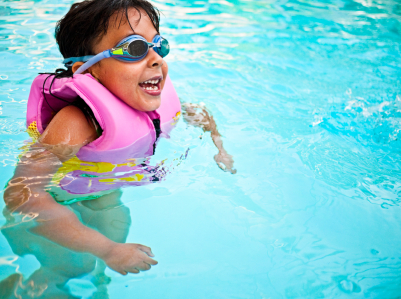Home Security: Water Safety
Water is necessary to sustain human life, but it can also be hazardous. Water is especially dangerous for children. Each year, approximately 1,000 kids die from drowning, making it the second most frequent cause of accidental death for individuals from age 5 to 24. The majority of these deaths occur in home swimming pools, but younger children can drown in as little as 2 inches of water. Fortunately, there are precautions you can take to protect your children from these dangers.
Dangers in the Home
Water can be found in many locations in and around the home. Pools, streams, lakes, buckets, fountains, ditches, sinks, and toilet bowls may all contain enough water to drown a young child. Children who are unsupervised, are too young to practice water safety, or don’t know how to behave responsibly around water are more likely to have accidents that result in drowning. For this reason, teaching your children about water safety is essential.
The Importance of Education
One of the best things you can do to protect your child from drowning is to learn how to swim. If you know how to swim, you will be able to help your child if he or she falls into a pool or lake. It can also be helpful to teach your child how to swim, especially if he or she is over 4 years of age. Younger kids may benefit from swimming lessons, but you should ask your pediatrician before enrolling them in classes.

Teach your kids not to run or push near water. Children should also know not to dive in locations that aren’t specifically designated as diving areas. In addition, make sure that any individual responsible for the safety of your child, such as a babysitter, knows how to swim and understands all the elements of water safety. Finally, make sure that all members of your family understand the risk of drowning and are aware of how quickly a situation can become serious.
Swimming Safety
Even children who know how to swim may be susceptible to drowning. No child should ever swim unsupervised, and younger children should always have a supervising adult within arm’s reach. Whenever your child is near water, you should also make sure that he or she is wearing a flotation device that fits properly and is approved by the United States Coast Guard. Manufacturers of these vests usually list the height and weight recommendations on each vest’s label. For children under 5, choose vests with head support and a strap between the legs.
children can become dehydrated quickly in the sun, and a dehydrated child is more likely to pass out in the water. To prevent dehydration, make sure your children drink plenty of fluids. Watch for dizziness and nausea, which are both signs of dehydration. In addition, you should always monitor the temperature of water to ensure that your child doesn’t get too cold. Water temperatures should remain between 82 and 86 degrees Fahrenheit for maximum comfort, and children should never swim in temperatures below 70 degrees. If your child is experiencing muscle cramps or is shivering, take him or her out of the water.
In Case of Emergency
If you cannot find your child, always check the pool first. If you find your child in the water, get him or her out as quickly as possible. If the child is unresponsive, call 911. Check air passages to ensure that they aren’t obstructed and begin CPR. If you do not know how to do CPR, ask the 911 operator for instructions.
If your child is involved in an accident and you believe he or she has a neck injury, immobilize the neck and call 911. Immobilizing the neck prevents the child from sustaining further injuries while you wait for paramedics. Speak calmly to comfort the child. Monitor his or her breathing, and make sure the child remains on his or her back.
Resources for Adults
- Water and Pool Safety
- Water Safety – Prevention
- Water Safety for Children
- Kids and Water – Safety Do’s and Dont’s
- Home Water Hazards for Young Children
- Life Jackets
- Keeping Kids Safe Around Water
- Myths and Facts About Water Safety (PDF)
- CPR in Three Simple Steps
- Facts About Childhood Drowning (PDF)
